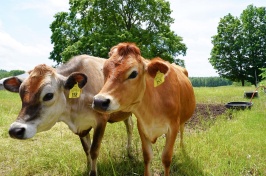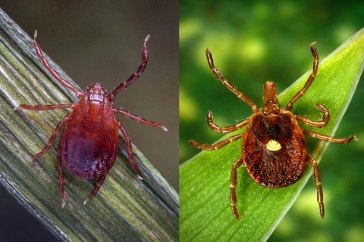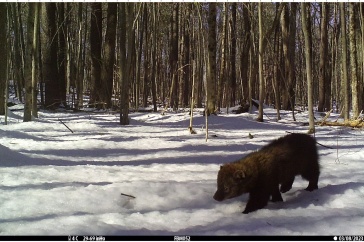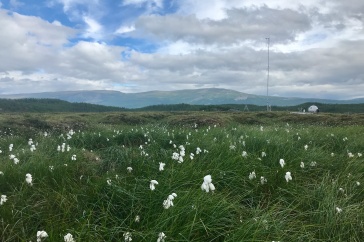
Through genetic analysis, the investigators found that the Listeria in one of the foxes that is similar to this one was resistant to multiple antibiotics and was highly virulent. Credit: VJ Anderson, under CC BY-SA 4.0.
Listeria has been found in two New Hampshire wild gray foxes by investigators at the New Hampshire Veterinary Diagnostic Laboratory at the University of New Hampshire. A zoonotic disease, the bacterium Listeria monocytogenes can sicken both people and farm animals. Some strains can be particularly important if they are resistant to multiple antibiotics and carry genes that lead to more severe diseases in infected people or animals.

investigators at the New Hampshire Veterinary Diagnostic Laboratory
at the University of New Hampshire. A zoonotic disease, the bacterium
Listeria monocytogenes can sicken both people and farm animals.
Credit: Vermont Fish and Wildlife Department.
“Listeria monocytogenes is a reportable disease to both human and veterinary state public health officials. It is one big reason why pregnant women shouldn’t eat cold cuts and soft cheeses,” said David Needle, senior veterinary pathologist, pathology section chief and associate clinical professor with New Hampshire Veterinary Diagnostic Laboratory at UNH.
Through genetic analysis, the investigators found that the Listeria in one of the foxes was resistant to multiple antibiotics and was highly virulent.
“The Listeria from the first fox in the paper had 13 antibiotic resistance genes and 183 virulence genes, which means it would be resistant to multiple classes of antibiotics and have a high potential for causing disease. This is important as we have seen an increase in Listeria diagnoses at the lab. These foxes are part of that picture, but exactly how we don’t know yet,” Needle said. “However, the antibiotic resistance indicates that there is an ongoing need to test animals for resistance, as well as a need to fund research into resistance across human and animal medicine.”
According to Patrick Tate, a wildlife biologist with the New Hampshire Fish and Game Department, antibiotic resistance is an important measure to track because some pathogens are zoonotic diseases or can become zoonotic. “Zoonotic pathogens have the ability to significantly impact human health, impact agricultural animals, and cause significant impact to the food supply chain. To effectively respond to outbreaks requires the utmost understanding of viruses, fungi, parasites, and bacteria,” he said.
New Hampshire State Veterinarian Stephen K. Crawford underscored the concern about antibiotic resistance.
“The use of antibiotics in food animal medicine is very tightly regulated. Regulating access to antibiotics can only do so much. Public messaging campaigns have targeted physicians, veterinarians, and their patients and clients in the past several years. Client compliance with proper prescription use and inappropriate disposal of unused antibiotics such as flushing down the toilet and giving to other people both present risks to the development of bacterial resistance. Clearly, antibiotic resistant organisms can make their way into wildlife and the environment through many routes, and likely back to both humans and domestic animals, as well. We all need to continue to do our best to be judicious in our choices of if, when, and what to use as antibiotic therapies,” Crawford said.
In the 33 months since the first fox submission, the veterinary diagnostic lab has diagnosed Listeria monocytogenes in 15 animals. In the 48 months prior to this, just three cases of Listeria were diagnosed. The 15 animals recently diagnosed include 10 goats, two sheep, one cow, and the two foxes.
“It is important that we found Listeria monocytogenes in these two foxes as they are free-ranging, wild animals carrying and infected by a bacterium that causes disease in farm animals and people. We have not had the diagnosis in a wild animal prior to these two cases. It is of potentially increased importance since we have been seeing a significant increase in Listeria in farm animals at the same time as in these wild foxes,” Needle said.
In addition to Listeria monocytogenes, both foxes also were infected with a distinct strain of canine distemper virus that is unique to wildlife in New England. Last year, Needle and collaborators reported they had found this strain in three fishers, two gray foxes, one skunk, one raccoon, and one mink. Canine distemper virus is highly contagious and causes severe disease in infected animals, which include domesticated dogs.
One fox also was infected with the emerging virus Skunk Adenovirus-1, the first time it has been reported in a fox or any canid in the world. Two years ago, Needle identified the first case of Skunk Adenovirus-1 in the United States when he and colleagues described the rare respiratory disease, which is not known to be zoonotic, in tissues of a hedgehog submitted for diagnostic testing. This hedgehog represented only the third reported detection of the virus worldwide. Since that time, the virus has also been reported to have infected porcupines in New York and maritime Canada.
According to Needle, Skunk Adenovirus-1 may be just emerging. Its diagnosis in multiple species indicates that it may be able to infect even more species.
“Monitoring wildlife for known pathogens is instrumental for the understanding of threats to livestock, pets, human health, and wildlife populations. As the environment alters and pathogens evolve, and adapt to infect alternative host, it is important to monitor for emergent diseases,” Tate said.
"People should not interact with wildlife and they should vaccinate their pets and livestock as their veterinarian recommends. Interactions with wildlife are best left to professionals – any suspicious, aggressive, or ill wildlife should be reported to New Hampshire Fish and Game, who will triage and assign appropriate personnel to address any perceived threat,” Needle said.
This research is reported in the journal Pathogens (DOI: 10.3390/pathogens9070591). Collaborating scientists include Inga F. Sidor and Robert Gibson, New Hampshire Veterinary Diagnostic Laboratory at UNH; Jacqueline L. Marr, Animal Health Diagnostic Center, Cornell University; Cooper J. Park and Cheryl P. Andam, UNH College of Life Sciences and Agriculture; Annabel G. Wise, Dalen Agnew, and Roger K. Maes, Veterinary Diagnostic Laboratory, Michigan State University; Rebecca P. Wilkes, Animal Disease Diagnostic Laboratory, Purdue University; Eman A. Anis, Pennsylvania Animal Diagnostic Laboratory System, University of Pennsylvania; Julie C. Ellis, Northeast Wildlife Disease Cooperative, University of Pennsylvania; Patrick Tate, New Hampshire Fish and Game; and Abigail Mathewson and Christopher Benton, Division of Public Health Services, New Hampshire Department of Health and Human Services.
This research is supported by the New Hampshire Agricultural Experiment Station and the State of New Hampshire. It is part of the Wildlife One Health Network of NH (WON NH), a nascent collaborative interdisciplinary, multi-institute network of diagnosticians and researchers that is part of a global movement that unites physicians, veterinarians, ecologists, and many other life science professionals in addressing and preventing health threats in people, animals, and the environment.
As part of the NH Agricultural Experiment Station at UNH, the New Hampshire Veterinary Diagnostic Laboratory serves the state of New Hampshire as a key partner with the New Hampshire Commissioner of Agriculture and State Veterinarian in their efforts to monitor and control important animal diseases. The lab also provides diagnostic services to hundreds of veterinarians from New Hampshire and New England who use the lab’s histopathology, microbiology, serology, and necropsy services for the diagnosis of animal diseases in pets, farm animals, wildlife, zoo, and marine animals.
Founded in 1887, the NH Agricultural Experiment Station at the UNH College of Life Sciences and Agriculture is UNH’s original research center and an elemental component of New Hampshire's land-grant university heritage and mission. We steward federal and state funding, including support from the USDA National Institute of Food and Agriculture, to provide unbiased and objective research concerning diverse aspects of sustainable agriculture and foods, aquaculture, forest management, and related wildlife, natural resources and rural community topics. We maintain the Woodman and Kingman agronomy and horticultural research farms, the Macfarlane Research Greenhouses, the Fairchild Dairy Teaching and Research Center, and the Organic Dairy Research Farm. Additional properties also provide forage, forests and woodlands in direct support to research, teaching, and outreach.
-
Written By:
Lori Tyler Gula, Ph.D., '19 | NH Agricultural Experiment Station | lori.gula@unh.edu | 603-862-1452


















































